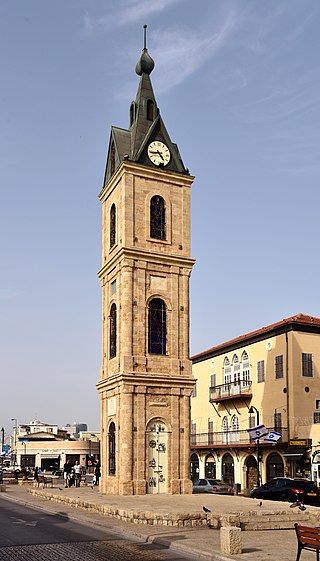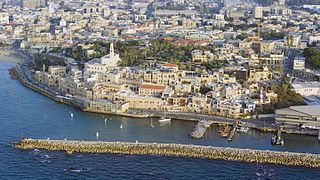Related Research Articles
Abba Arikha, commonly known as Rav (רב), was a Jewish amora of the 3rd century. He was born and lived in Kafri, Asoristan, in the Sasanian Empire.
Amoraim refers to Jewish scholars of the period from about 200 to 500 CE, who "said" or "told over" the teachings of the Oral Torah. They were primarily located in Babylonia and Ancient Palestine. Their legal discussions and debates were eventually codified in the Gemara. The Amoraim followed the Tannaim in the sequence of ancient Jewish scholars. The Tannaim were direct transmitters of uncodified oral tradition; the Amoraim expounded upon and clarified the oral law after its initial codification.

Keturah was a wife and a concubine of the Biblical patriarch Abraham. According to the Book of Genesis, Abraham married Keturah after the death of his first wife, Sarah. Abraham and Keturah had six sons.

Haman is the main antagonist in the Book of Esther, who according to the Hebrew Bible was an official in the court of the Persian empire under King Ahasuerus, commonly identified as Xerxes I but traditionally equated with Artaxerxes I or Artaxerxes II. As his epithet Agagite indicates, Haman was a descendant of Agag, the king of the Amalekites. Some commentators interpret this descent to be symbolic, due to his similar personality.
Rabbah bar Naḥmani was a Jewish Talmudist known throughout the Talmud simply as Rabbah. He was a third-generation amora who lived in Sassanian Babylonia.

Lamech is a person in Cain's genealogy in the fourth chapter of the Book of Genesis. His father was named Methushael. This Lamech is distinguished from the other Lamech mentioned subsequently in Genesis, who was a descendant of Adam's third son Seth.

Simeon the Righteous or Simeon the Just was a Jewish High Priest during the Second Temple period. He is also referred to in the Mishnah, where he is described as one of the last members of the Great Assembly.
Buni ben Gurion, also called Nicodemus, was a wealthy Jewish man who lived in Jerusalem in the 1st century AD. He is believed by some to be identical to the Nicodemus mentioned in the Gospel of John. Elsewhere he is discussed in Josephus' history, The Jewish War, and later, rabbinic works: Lamentations Rabbah, Ecclesiastes Rabbah, the Babylonian Talmud, and Avot of Rabbi Natan.
Adda bar Ahavah or Adda bar Ahabah is the name of two Jewish rabbis and Talmudic scholars, known as Amoraim, who lived in Babylonia.
Tanhuma bar Abba was a Jewish amora of the 5th generation, one of the foremost aggadists of his time.

Nasr was apparently a pre-Islamic Arabian deity of the Himyarites. Reliefs depicting vultures have been found in Himyar, including at Maṣna'at Māriya and Haddat Gulays, and Nasr appears in theophoric names. Nasr has been identified by some scholars with Maren-Shamash, who is often flanked by vultures in depictions at Hatra. Hisham ibn Al-Kalbi's Book of Idols describes a temple to Nasr at Balkha, an otherwise unknown location. Some sources attribute the deity to "the dhū-l-Khila tribe of Himyar". Himyaritic inscriptions were thought to describe "the vulture of the east" and "the vulture of the west", which Augustus Henry Keane interpreted as solstitial worship; however these are now thought to read "eastward" and "westward" with n-s-r as a preposition. J. Spencer Trimingham believed Nasr was "a symbol of the sun".

The Jaffa Clock Tower stands in the middle of the north end of Yefet Street in Jaffa, Tel Aviv. The tower, built of limestone, incorporates two clocks and a plaque commemorating the Israelis killed in the battle for the town in the 1948 Arab–Israeli War.

Jaffa, in Hebrew Yafo and in Arabic Yafa and also called Japho or Joppa, the southern and oldest part of Tel Aviv-Yafo, is an ancient port city in Israel. Jaffa is known for its association with the biblical stories of Jonah, Solomon and Saint Peter as well as the mythological story of Andromeda and Perseus, and later for its oranges.
Jeremiah bar Abba was a Babylonian rabbi who lived around the mid-3rd century. He is cited many times in the Jerusalem Talmud, where he is mentioned simply as Rav Jeremiah, without his patronymic name.
Abba or Raba (Rabbah) Bar Jeremiah was Babylonian rabbi of the third century.

Avdimi of Haifa was among the greatest of the amoraim of Eretz Israel who flourished during the 3rd and 4th centuries.
Rabbi Isaac Nappaha, or Isaac the smith, was a rabbi of the 3rd-4th centuries who lived in the Galilee.

Sefaria is an online open source, free content, digital library of Jewish texts. It was founded in 2011 by former Google project manager Brett Lockspeiser and journalist-author Joshua Foer. Calling itself "a living library of Jewish texts", Sefaria relies on volunteers to add texts and translations. The site provides cross-references and interconnections between different texts. Hebrew, Aramaic, and Judeo-Arabic texts are provided under a free license in the original and in translation. The website also provides a tool for creating source sheets.

Ḥanan bar Rava or Ḥanan bar Abba was a Talmudic sage and second-generation Babylonian Amora. He lived in Israel, moved to Babylonia with Abba b. Aybo, and died there ca. 290 CE. He is distinct from the late-generation Babylonian Amora of the same name who apparently conversed with Ashi.
"We do not rule based on categorical inferences in monetary cases" is a principle in halakha followed by Jewish batei din. According to this principle, a categorical inference is not sufficient evidence for the decisor to reallocate property. By "categorical inference" is meant "inference about the specific from evidence about its category." In the classic example, the decisor may not infer that a particular individual purchased an ox for the purpose of plowing with it, despite a stipulation that most purchasers share that purpose. The monetary exception emerges from conflict between the general principle of categorical inference, wherein doubt about specific data can be resolved by evidence for a stipulation about the wider category, and the contract-law principle of possession, wherein the burden of proof is on any claimant seeking reallocation of property.
References
- ↑ Hayyim Joseph David Azulai. Birkei Yosef: Orach Chaim , pg. 468.
- ↑ Aharon Heiman. Toldos Tannaim ve-Amoraim [ permanent dead link ], Vol 1., pg. 136.
- ↑ "Jerusalem Talmud Moed Kattan 18a:1". www.sefaria.org. Retrieved 2021-03-11.
- ↑ "Bereishit Rabbah 38". www.sefaria.org. Retrieved 2021-03-11.